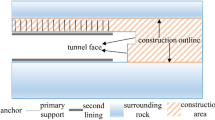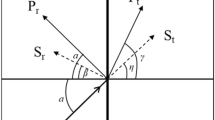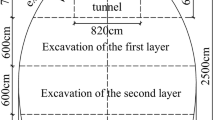Abstract
This paper describes a new method using water–silt composite blasting for tunneling and the field tests conducted in the Tieshanping tunnel, Chongqing City, China. In this method, water–silt composite is substituted for the traditional pure silt stemming of the blast holes. Because of the incompressibility of water, the attenuation of the blasting wave is postponed and the effect of the blast air extended. The water–silt blasting method resulted in a larger crack zone, improved the breakage of rock, reduced the rock heap, lowered the dust and saved explosive. The stability of the surrounding rock was studied using theoretical analysis, in situ measurements and numerical modeling. The measured displacement at the tunnel crown was in good agreement with the theoretical and numerical results.
Résumé
L’article décrit une nouvelle méthode utilisant un composé eau-argile dans les opérations de creusement de tunnel à l’explosif. Les essais de terrain ont été réalisés dans le tunnel de Tieshanping de la municipalité de Chongqing (Chine). Dans cette méthode, le composé eau-argile remplace le traditionnel bourrage d’argile pure dans les trous de foration. Du fait de l’incompressibilité de l’eau, l’onde de choc est atténuée et l’onde aérienne augmentée. L’utilisation du composé eau-argile a pour conséquence la formation d’une zone de fissuration plus étendue, une fragmentation de la roche améliorée, une diminution du volume du tas abattu, une réduction des poussières et une économie de substances explosives. La stabilité des masses rocheuses environnantes a été étudiée suivant une analyse théorique, des mesures en place et une simulation numérique. Les déplacements mesurés en couronne du tunnel étaient en bon accord avec les résultats théoriques et numériques.











Similar content being viewed by others
References
Bakke B, Stewart P, Ulvestad B, Eduard W (2001) Dust and gas exposure in tunnel construction work. AIHAJ 62:457–465
Bohloli B, Gustafson G, Ronge B (2001) A laboratory study on reducing the quantity of rock fines at failure: application to rock blasting and crushing. Bull Eng Geol Env 60:271–276
Cristescu N, Fota D, Medves E (1987) Tunnel support analysis incorporating rock creep. Int J Rock Mech Min Sci Geomech Abastr 26(4):321–330
Cui ZD, Yuan L, Yan CL (2010) Water-silt composite blasting for tunneling. Int J Rock Mech Min Sci 47(6):1034–1037
Innaurato N, Mancini R, Cardu M (1998) On the influence of rock mass quality on the quality of blasting work in tunnel driving. Tunneling Undergr Space Technol 13(1):81–89
Mancini R, Badino V, Innaurato N, Fornaro M, Cardu M, Baldo GL, Borla G (1996) Technical and economic aspects of tunnel blasting accuracy control. Tunneling Undergr Space Technol 11(4):455–463
Thuro K (1997) Drillability prediction: geological influences in hard rock drill and blasting tunneling. Geol Rundsch 86:426–438
Wong PH, Phoon WH, Tan KT (1988) Industrial hygiene aspects of tunneling work for the mass rapid transit system in Singapore. Appl Ind Hyg 3:240–243
Zhu S, Zhou C (1994) Viscoelastic mechanical analysis of stability in circular underground tunnels (in Chinese). J Tongji Univ 22(3):329–333
Acknowledgments
The work presented in this paper was supported by a talent introduction research grant and a Qihang plan grant from China University of Science and Technology.
Author information
Authors and Affiliations
Corresponding author
Rights and permissions
About this article
Cite this article
Cui, ZD. Effect of water–silt composite blasting on the stability of rocks surrounding a tunnel. Bull Eng Geol Environ 70, 657–664 (2011). https://doi.org/10.1007/s10064-010-0346-3
Received:
Accepted:
Published:
Issue Date:
DOI: https://doi.org/10.1007/s10064-010-0346-3




